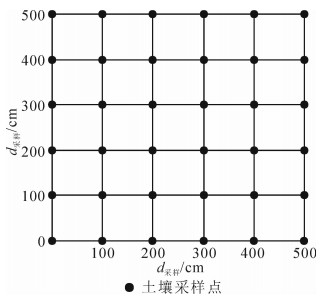-
中国荒漠地区幅员辽阔,环境治理工作非常严峻。环境治理中一个非常重要的环节就是植被恢复,而植物的生长离不开土壤。植物可以通过产生或聚集土壤水分和养分来提高植物周边土壤资源的可利用性进而影响幼苗的生长发育[1],形成肥岛效应[2]。在干旱半干旱区,明确植被和土壤资源之间的反馈关系以及肥岛效应在生态系统中的生态功能非常重要[3-4],这不仅能为土地管理者提供重要植被和土壤的信息,还能避免在今后野外实验时采集的土壤形成空间自相关[5]。当前,国内外关于植物与土壤资源分布关系的研究多关注于土壤资源分布的斑块大小与植被冠层大小的对比,以此来判断土壤资源分布是否受到某一植物的影响。如GALLARDO[6]发现氮(N)和有机质(SOM)的斑块大小和分布格局与树冠相吻合,并且半方差范围与树冠直径相吻合,得出树木对氮和有机质有显著的影响。这一方法虽然容易理解,但并不是非常准确,并且土壤资源与植被关系的一些细节不易确定。相较而言,作为一种经典的统计学方法,空间点格局分析能反映多个研究对象相互之间的关联性和关联范围,它常常应用于分析各种不同尺度的种群分布格局及种间关系,以揭示植被的演替规律[7-10],而在植被与土壤空间分布的研究中,空间点格局分析的应用并不常见。为更深入分析内蒙古西部干旱区植被与土壤资源格局的相互关系,了解不同植被群落条件下,不同优势灌木物种的土壤资源聚集效应,本研究以内蒙古乌海周边地区为研究区,采用空间点格局分析方法,对不同群落条件下灌木物种与不同土壤养分间的点格局关系进行了分析,旨在揭示植物与不同土壤资源的聚集形式,对生态恢复中植物种的初步选择具有重要的意义。
HTML
-
乌海市位于内蒙古西部干旱区,地处黄河上游,东面和北面接鄂尔多斯,西接阿拉善,南部为宁夏。研究区及样方调查以乌海周边地区为主(图 1)(40°27′01″ ~38°35′44″N,105°57′15″~107°48′21″E)。地势两边高中间低,处在贺兰山脉北部余端,并以此为界分为西部的草原化荒漠(1,2,3,4,5号植被群组所处区域)和东部的荒漠草原(6,7,8,9号植被群组所处区域)[11]。该地区气候为典型的大陆性气候,夏季炎热高温,冬季寒冷少雪,春秋干旱。昼夜温差大,日照时间长,可见光照资源丰富。年平均气温为9.8 ℃,年平均降水量为157.9 mm,年平均蒸发量为3 249.0 mm[12]。占比最高的3类土壤为棕钙土(23.3%),灰漠土(22.0%)和风沙土(7.1%)。
-
用于植被恢复的植物种多以乡土树种为主,菊科Asteraceae的沙蒿Artemisia desertorum和蝶形花科Papilionaceae的锦鸡儿属Caragana灌木是主要建群种,且在乌海市周边分布广泛,在荒漠草原和草原化荒漠均有分布,具有重要的研究价值,所以选择沙蒿和锦鸡儿属灌木作为主要研究对象。
-
2017年8月,在乌海市周边地区根据不同植被群落组成共选择9个植被群组进行调查,取5 m × 5 m灌木样方3个·群组-1和1 m × 1 m草本样方3个·群组-1,样方边分别沿南北和东西进行布设。调查样方中灌木和草本植物的基本组成情况后,选取其中1个最具统计学意义的灌木样方,进行土样采集和植物坐标测定。
在选择的样方中,面朝正北,以样方左边朝正北设y轴,底边朝正东设x轴,两边交叉点为原点建立坐标系,以样方坐标轴原点为基准点进行土样采集,各个采样点间隔其他4个方向的采样点均为100 cm(图 2),取0~20 cm土层的混合土样1.0 kg·采样点-1,共采集36 × 9=324份土样;再在此坐标系基础上对样方中每株灌木的坐标点进行测定记录,每株灌木坐标点位置为根与茎连接处中心。
-
本研究选择了有机质(SOM)、全氮(TN)和全磷(TP)等3种土壤养分的代表性参数进行测定。将土样风干并去除杂质,碾碎后过1 mm筛,过筛土样进一步研磨,一部分通过60目筛,采用重铬酸钾稀释热法测定土壤有机质;一部分过100目筛,将过筛土样消煮后使用全自动化学分析仪(smartchm 200)测定土壤的全氮和全磷[13-14]。
-
本研究针对植被与土壤参数之间的关系,采用二元点格局分析方法进行分析[15-16]。Ripley’s k(x)函数可分为单变量和双变量的k函数,单变量k函数主要研究单一地理点群对象的内在空间格局分布模式,而双变量k函数主要用于研究一类事件点的分布模式是否依赖于另外一类事件点,或者前者是否会对后者的分布产生影响。对植物坐标点用k11(r)表示,对土壤采样点用k22(r)表示,可以用下式计算灌木和土壤养分的个体在距离(尺度)r内的数目k12:${k_{12}} = \frac{a}{{{n_1}{n_2}}}\sum\limits_{i = 1}^{{n_1}} {\sum\limits_{j = 1}^{{n_2}} {\frac{1}{{{w_{ij}}}}} } {i_r}\left( {{u_{ij}}} \right) $。其中:uij为植物坐标点(i)和土壤采样点(j)之间的距离:当uij≤r时,ir(uij)=1,反之则等于0;wij为以点i为圆心,uij为半径的圆周长在样方面积a中的比例,其中一个点可被观察到的概率;n1和n2分别表示植物坐标点和土壤采样点的个数。$\sqrt{k_{12}(r) / \pi} $在表现格局关系时更有用,并且与r有线性关系。假设$ l_{12}(r)=\sqrt{k_{12}(r) / \pi}-r$,则当l12(r)=0时,表明2个事件在r尺度下无关联,l12(r)>0时表明两者正相关,l12(r)<0时则为负相关。采用Monte-Carlo方法计算上下包迹线,如果在此距离尺度上研究个体的l12(r)的值位于包迹线内,则认为研究个体属于随机分布,两者无关联;如果高于上包迹线为聚集分布,两者正相关,低于下包迹线为均匀分布,两者负相关。
-
将灌木空间分布数据和土壤空间分布数据(土壤不同养分含量最高的前20%点位)代入点格局模型,采用R语言中的“ads”包进行点格局分析得出植物和土壤养分分布的相关性和空间格局关联尺度r。若植物和土壤养分为聚集分布,则关联尺度r表示植物和土壤养分聚集范围,该范围内存在受植物影响的土壤养分斑块。若植物和土壤养分为随机分布,则植物的空间分布与土壤养分无关,以N表示。若植物和土壤养分为均匀分布,则在关联尺度r下,植物与土壤养分相互排斥,植物无法聚集土壤养分斑块,此种情况设定r为负值表示在该尺度下植物与土壤养分分布关系为显著负相关。
2.1. 灌木种选取
2.2. 样方调查
2.3. 土壤性质分析
2.4. 点格局分析法
2.5. 数据分析
-
研究区植被以灌木或半灌木和草本为主,主要有8种灌木和半灌木(表 1)。半灌木包括菊科的沙蒿;灌木包括蝶形花科的锦鸡儿Caragana sinica,狭叶锦鸡儿Caragana stenophylla,毛刺锦鸡儿Caragana tibetica和柠条锦鸡儿Caragana korshinskii;藜科Chenopodiaceae的梭梭Haloxylon ammodendron;蒺藜科Zygophyllaceae的白刺Nitraria tangutorum和霸王Sarcozygium xanthoxylon。
群组号 优势物种 研究物种 盖度/% 研究物种数/株 研究物种平均冠幅/cm 草本种类/数量 1 沙蒿 沙蒿 28.7 12 79.0 1/7 2 沙蒿+白刺 沙蒿 49.8 11 58.5 1/2 3 锦鸡儿+白刺+霸王 锦鸡儿 24.6 20 31.8 4/8 4 狭叶锦鸡儿+霸王 狭叶锦鸡儿 28.5 4 95.4 5/11 5 柠条锦鸡儿+梭梭 柠条锦鸡儿 51.5 2 122.0 4/14 6 沙蒿+柠条锦鸡儿 沙蒿 50.7 4 83.1 5/36 柠条锦鸡儿 2 210.3 7 毛刺锦鸡儿 毛刺锦鸡儿 36.2 23 47.1 6/24 8 沙蒿+锦鸡儿 沙蒿 47.6 20 61.6 7/43 锦鸡儿 30 10.6 9 沙蒿 沙蒿 44.0 19 93.1 1/20 Table 1. Investigation of the plots
研究灌木主要为菊科的沙蒿和蝶形花科的锦鸡儿属灌木。沙蒿主根明显,木质或半木质,侧根少数,主根在0~20 cm土层生物量最多;锦鸡儿主侧根发达,根幅扩展较宽,并具有成层现象;柠条锦鸡儿的根深且粗壮,可以分为独生根和簇生根2类,前者相对后者更适合在干旱半干旱地区生长,且氮富集量更大;狭叶锦鸡儿根系发达,主根和侧根均较粗壮,根蘖性很强[17-19]。
-
在草原化荒漠,沙蒿与全氮的关联尺度分别为75和100 cm,相对于沙蒿,该区域锦鸡儿属的灌木与全氮的关联尺度更大,其中以狭叶锦鸡儿关联尺度最大,为250 cm,其次为锦鸡儿,关联尺度230 cm,最后柠条锦鸡儿为150 cm,表明锦鸡儿属灌木对全氮的聚集范围大于沙蒿(表 2)。根据灌木与土壤全氮的聚集关系,在该区域可以考虑采用沙蒿和锦鸡儿属灌木聚集土壤全氮,一方面灌木对全氮的聚集作用能够有效改善土壤结构和营养组成[20];另一方面可以根据不同灌木与土壤全氮的关联尺度选择出适合在不同环境下进行植被恢复的物种,比如在土地非常贫瘠的荒漠区域可以采用锦鸡儿属灌木进行植被恢复,以较少的株数治理更大的范围;对于具有少许草本植物的荒漠区域可以采用沙蒿聚集氮素,以防止养分空间错位,引起群落不稳定从而影响草本植被生长[21]。
群组号 优势物种 与土壤参数有关联性的物种 关联尺度r/cm 1 沙蒿 沙蒿 100 2 沙蒿+白刺 沙蒿 75 3 锦鸡儿+白刺+霸王 锦鸡儿 230 4 狭叶锦鸡儿+霸王 狭叶锦鸡儿 250 5 柠条锦鸡儿+梭梭 柠条锦鸡儿 150 6 沙蒿+柠条锦鸡儿 沙蒿 N 柠条锦鸡儿 N 7 毛刺锦鸡儿 毛刺锦鸡儿 N 8 沙蒿+锦鸡儿 沙蒿 N 锦鸡儿 N 9 沙蒿 沙蒿 N 说明:表中各灌木与土壤参数具有相关性的均为正相关;N表示植物空间分布与土壤养分无关 Table 2. Scale of spatial correlation between shrubs and TN
在荒漠草原,沙蒿+锦鸡儿,沙蒿+柠条锦鸡儿,毛刺锦鸡儿和沙蒿群组中锦鸡儿属灌木和沙蒿与全氮无关联,可能是因为研究区东部荒漠草原降水量多于西部草原化荒漠[22],使得东部草本数量较于西部更多,这点在调查中也反映出来,而草本植物对于灌木的肥岛效应有较大的干扰[23],由于草本对土壤养分分布的影响,使得荒漠草原的灌木的肥岛效应在该研究尺度下没有草原化荒漠显著。
-
土壤全磷仅与在草原化荒漠区域的锦鸡儿+白刺+霸王群组中的锦鸡儿有聚集关系,关联尺度为50 cm,其他植被群组中灌木与全磷无聚集关系,包括生长在荒漠草原的锦鸡儿在内,均为随机分布。这表明相较于其他锦鸡儿属灌木和沙蒿,锦鸡儿在草原化荒漠中对全磷具有聚集作用,但并不能聚集荒漠草原的全磷。全磷与锦鸡儿的2个关联尺度包含了较小和较大2个聚集范围,在草原化荒漠土壤非常贫瘠的区域或有少许草本植物的区域均可以考虑采用锦鸡儿聚集全磷(表 3)。
群组号 优势物种 与土壤参数有关联性的物种 关联尺度r/cm 1 沙蒿 沙蒿 N 2 沙蒿+白刺 沙蒿 N 3 锦鸡儿+白刺+霸王 锦鸡儿 50 4 狭叶锦鸡儿+霸王 狭叶锦鸡儿 N 5 柠条锦鸡儿+梭梭 柠条锦鸡儿 N 6 沙蒿+柠条锦鸡儿 沙蒿 N 柠条锦鸡儿 N 7 毛刺锦鸡儿 毛刺锦鸡儿 N 8 沙蒿+锦鸡儿 沙蒿 N 锦鸡儿 N 9 沙蒿 沙蒿 N 说明:表中各灌木与土壤参数具有相关性的均为正相关;N表示植物空间分布与土壤养分无关 Table 3. Scale of spatial correlation between shrubs and TP
-
土壤有机质仅与沙蒿和毛刺锦鸡儿表现关联性。沙蒿在荒漠草原和草原化荒漠都聚集有机质,关联尺度分别为190和200 cm,但是聚集有机质的群组中只有沙蒿1种灌木,可以考虑构建沙蒿群落聚集有机质。毛刺锦鸡儿在荒漠草原区与有机质表现出45 cm的关联尺度,说明毛刺锦鸡儿在荒漠草原对有机质具有聚集作用,该区域也可以考虑采用毛刺锦鸡儿聚集有机质(表 4)。
群组号 优势物种 与土壤参数有关联性的物种 关联尺度r/cm 1 沙蒿+白刺 沙蒿 N 2 沙蒿 沙蒿 200 3 锦鸡儿+白刺+霸王 锦鸡儿 N 4 狭叶锦鸡儿+霸王 狭叶锦鸡儿 N 5 柠条锦鸡儿+梭梭 柠条锦鸡儿 N 6 沙蒿+柠条锦鸡儿 沙蒿 N 柠条锦鸡儿 N 7 毛刺锦鸡儿 毛刺锦鸡儿 45 8 沙蒿+锦鸡儿 沙蒿 N 锦鸡儿 N 9 沙蒿 沙蒿 190 说明:表中各灌木与土壤参数具有相关性的均为正相关;N表示植物空间分布与土壤养分无关 Table 4. Scale of spatial correlation between shrubs and SOM
3.1. 植被情况
3.2. 灌木与全氮聚集关系
3.3. 灌木与全磷聚集关系
3.4. 灌木与有机质聚集关系
-
植物可以通过不同部位的不同功能将土壤养分聚集在周围,这一系列植物根冠对土壤养分的聚集作用和聚集范围通过点格局分析计算呈现出来。
第一,锦鸡儿属灌木通过根系与根瘤菌共生形成根瘤进行固氮[24-25],土壤中氮质量分数的变化与锦鸡儿属灌木的根系分布有非常密切的关系。在草原化荒漠区域,狭叶锦鸡儿由于具有很强的根蘖性,往往几株的根系连成一片,较大的根系范围聚集了更多的土壤全氮斑块,使得狭叶锦鸡儿与全氮的关联尺度达250 cm;而锦鸡儿分布数量较多,成群分布,根系延展分布范围较大,使得固氮范围增大,锦鸡儿与全氮的关联尺度达230 cm;柠条锦鸡儿在区域中虽然分布稀疏,但是灌丛相对较大,从与全氮的关联尺度来看,与狭叶锦鸡儿和锦鸡儿多株聚集全氮不同,全氮可能更多的聚集在每株柠条锦鸡儿根冠范围内。基于以上原因,狭叶锦鸡儿和锦鸡儿与全氮的关联尺度近似,而两者与全氮的关联尺度大于柠条锦鸡儿与全氮的关联尺度。反观该区域的沙蒿,与全氮也具有关联尺度,但是沙蒿不属于固氮植物,土壤中从植物获取的氮素更多的来源于其枯落物的分解[26],从2个不同沙蒿植物群中沙蒿的平均冠幅来看,沙蒿群中的沙蒿大于沙蒿+白刺群中的沙蒿,两者与全氮关联尺度分别为100和75 cm,前者大于后者,表明全氮的关联尺度可能受沙蒿冠层的影响。由于沙蒿群中的氮素主要来源于枯落物,而锦鸡儿属灌木群中的氮素还可以来源于根瘤菌固氮,荒漠地区植物根系广深且强大[27],相较于冠层有更大的分布范围,所以锦鸡儿属灌木与全氮的关联尺度整体大于沙蒿与全氮的关联尺度。
第二,西北干旱地区的土壤全磷含量非常低,在低磷胁迫下,磷高效植物通过增加有机物的分泌,尤其是一些低分子量的有机酸来促进植物对土壤难溶性磷的活化与吸收[28],比如蝶形花科植物在感受到磷亏缺后,根系有机酸的分泌量显著增加,增加4.0~6.5倍,以此来活化吸收土壤难溶性磷[29],在本研究中,草原化荒漠区域的锦鸡儿表现出全磷的聚集作用,可能是由于贫瘠的土壤加上白刺和霸王的养分竞争,刺激锦鸡儿根系对难溶性磷的活化吸收,使磷素聚集在锦鸡儿根系周围。锦鸡儿与全磷表现出的关联尺度,在该研究尺度下一定程度可以反映锦鸡儿个体的根系活化磷素的范围。
第三,土壤有机质不仅来源于植物枯落物,同时也来源于植物根的残体和根的分泌物,且不同植物的残体和分泌物的养分也不同[30]。在与有机质有关联的2个沙蒿群和1个毛刺锦鸡儿群中,群落中仅有1种灌木,灌木残体与根的分泌物分解产生的有机质只聚集在该种灌木周围,使得灌木与有机质表现出关联性。沙蒿根系在0~20 cm土层生物量最多,对该层土壤有机质质量分数有较大影响,使得沙蒿群中沙蒿与有机质的关联尺度达200和190 cm,沙蒿与有机质的关联尺度则反映了沙蒿根或冠的分布范围。而荒漠草原的毛刺锦鸡儿在多数量的草本植物的影响下聚集了有机质,且关联尺度与冠幅非常接近,一定程度说明该植被群有机质受毛刺锦鸡儿冠层的影响。
-
在乌海市西部草原化荒漠区域,全氮与锦鸡儿属灌木和沙蒿均有聚集关系,关联尺度狭叶锦鸡儿(250 cm)>锦鸡儿(230 cm)>柠条锦鸡儿(150 cm)>沙蒿(100 cm)>沙蒿+白刺群组的沙蒿(75 cm);与全磷存在聚集关系的仅有锦鸡儿,关联尺度为50 cm;与有机质存在聚集关系的仅有沙蒿,关联尺度为200 cm;在东部荒漠草原区域,全氮全磷与锦鸡儿属灌木和沙蒿均不存在聚集关系,有机质与毛刺锦鸡儿存在关联尺度为45 cm的聚集关系,与沙蒿存在关联尺度为190 cm的聚集关系。在较为干旱贫瘠的草原化荒漠区可以根据土壤需求考虑选择锦鸡儿属灌木或沙蒿聚集土壤养分;在荒漠草原区可以考虑选择毛刺锦鸡儿或沙蒿聚集有机质。运用点格局分析得出的灌木与土壤养分的关联尺度一定程度反映了根或冠的范围,深入揭示了植物与土壤养分之间的空间关系。但点格局分析仅能反映聚集范围内有土壤斑块受植物影响,无法明确一株植物影响几个土壤资源斑块或者一个土壤资源斑块受几株植物影响,植物斑块与土壤斑块关系量化需要更深入的研究。












 DownLoad:
DownLoad:
